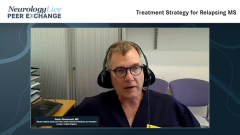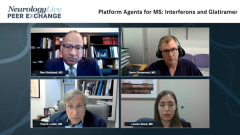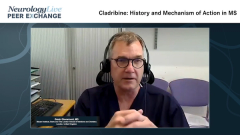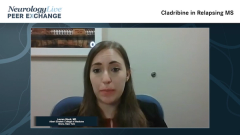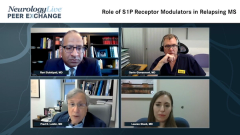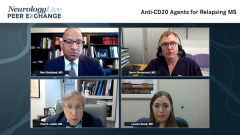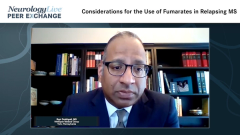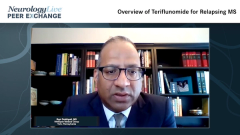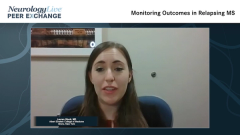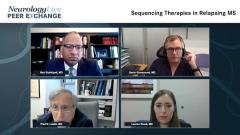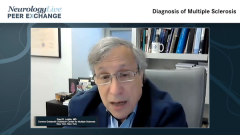
Biomarkers for Monitoring Treatment Response in Relapsing MS
Expert neurologists discuss current and future biomarkers relevant to relapsing multiple sclerosis including cerebrospinal fluid neurofilament.
Episodes in this series

Fred D. Lublin, MD: Let’s look ahead a bit. Gavin, I want you to take the lead on this. We mentioned biomarkers a little, at least neurofilament light, but where do you think we’re going with biomarkers?
Gavin Giovannoni, MD: I don’t think there’s any 1 biomarker that’s going to take the storm and that’s going to be it. They all add to the picture. We’ve been using CSF [cerebrospinal fluid] neurofilament as an activity marker for about…5 years in our practice. We find it very helpful in terms of not being sure if somebody has ongoing activity, and if the patient has raised neurofilament levels, that gives us some confidence. About 1 in every 10 patients will have raised neurofilament levels and the MRI will be inactive, and they wouldn’t have had obvious relapses or pseudo relapses. It helps sort out pseudo relapses from true relapses. So yes, I think it’s going to be incorporated into clinical practice, but it’s unlikely that it will be used in isolation. It’s going to have to be combined with all the other things we measure. And what’s going to be more valuable is not just 1 measurement, but a trajectory of measurements, to see what happens over time with the neurofilament levels. It’s going to come. The data are overwhelming. It’s a good prognostic marker, and it’s a response marker, but I think overall, it’s looking more like an inflammatory activity marker than a neurodegenerative marker.
Fred D. Lublin, MD: That’s the disappointing aspect, I think, of neurofilament because if you think about its measure of axonal damage, we would have hoped it would be a better marker of neurodegeneration. It’s the opposite, just what you said, it’s a very good predictor of inflammatory activity, on the order of close to MRI. In fact, combining the 2 is a very good way of looking for activity. But in and of itself, I find that a little disappointing in neurofilament.
Gavin Giovannoni, MD: I think the problem is, we don’t know enough about the peripheral metabolism of neurofilament, but I suspect it’s cleared quite rapidly. I think in the more advanced, progressive, smoldering phases of the disease, the dropout rate is so slow that you’re not going to be picking up raised levels.
Fred D. Lublin, MD: Any other fluid biomarkers that have grabbed your attention?
Gavin Giovannoni, MD: Yes, this is not in clinical practice, but I think we’re going to have to at some stage target those intrathecal B and plasma cells. I think the intrathecal B cell and plasma cell response is driving some of the progressive component of the disease. We’re going to have to start in the future to clear the CSF of oligoclonal bands and drop the free light chain levels. That’s a biomarker for a specific therapeutic target. There’s nothing in the periphery; you may say GFAP [glial fibrillary acidic protein], but I’m not sure how much that’s going to add to neurofilament in terms of monitoring. So nothing stands out as a prognostic or a treatment response marker. I think in terms of when to retreat, that’s a different story. You alluded to the concept that maybe we’re overtreating with anti-CD20 [monoclonal antibody] therapies and we should only redose when B-cell reconstitution occurs, but that’s a different question. That’s about optimizing the dosing frequency of anti-CD20 therapies, and that’s going to require a lot of work. I don’t think B cells are enough. We may have to look at memory B cells or subpopulations of memory B cells, for example.
Fred D. Lublin, MD: And maybe T regs [regulatory T cells]. Ravi or Lauren, any thoughts about biomarkers?
Ravi Dukkipati, MD: I don’t have any additional thoughts. I think it’s a matter of establishing more data sets for neurofilaments, for example, and making them more adaptable to day-to-day practice, as an added way to monitor how patients are doing. The goal is to have reliable markers that we can institute early to ensure that our patients are responding to therapy.
Fred D. Lublin, MD: Thank you all for watching this NeurologyLive® Peer Exchange. If you enjoyed the content, please subscribe to our e-newsletters to receive upcoming Peer Exchanges and other great content right in your inbox. Thank you for joining us.
Transcript Edited for Clarity
Newsletter
Keep your finger on the pulse of neurology—subscribe to NeurologyLive for expert interviews, new data, and breakthrough treatment updates.

